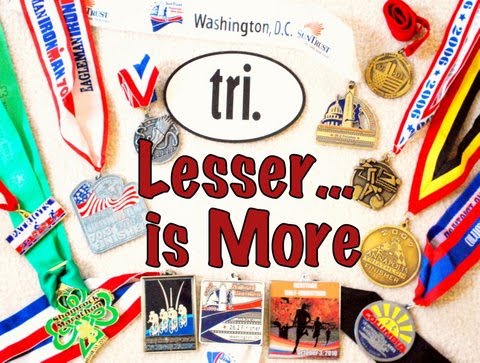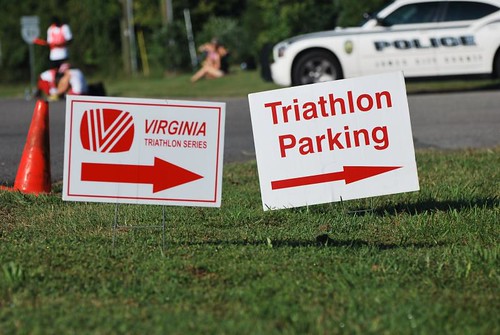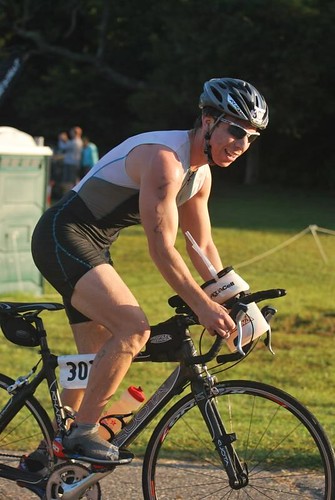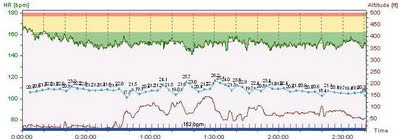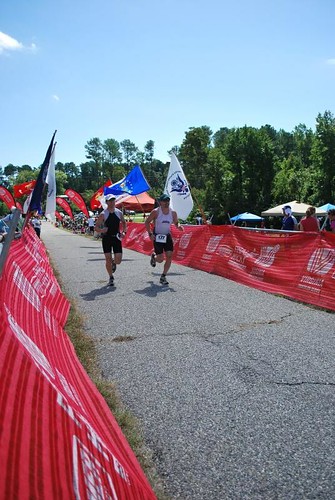Well, my big race for the year is in the books. I completed the Patriots Half after a long six months, pretty much focused on this race. I raced no other triathlons this year, but did a handful of bike rides to keep me focused on my training throughout the season. This was a drastic change from seasons before, where I would race 4-6 races. It kept me focused on one goal, so my training priorities never shifted. At the same time, without a true race to test my progress, it was a challenge to stay motivated at times.
With that, I give you the executive summary, because someone I know, doesn’t like my long reports. So without further ado for you attention deficit folks, here ya go. For everyone else, continue on reading.
Swim – 47:30
Felt good throughout first half, got off course in 2nd half due to not being able to review the changed course (current shifted) before the race, and probably swam a good bit extra.
T1 – 3:40
LONG .3 mile run up hill to transition area. Took wetsuit off after getting out of water so I could run easier to transition. Due to difficult mount line set up, pulled the plug on flying dismount, so I hopped on at the line.
Bike – 2:41:02 (21.6 MPH)
Fast, mostly flat course with a few rollers and false flats. Had an amazing ride and passed tons of people even though I was in the 1st swim wave. Kept my nutrition plan on pace until I got sloshy in stomach with 10 miles to go.
T2 – 1:12
Stomach started cramping a bit as I slipped on my shoes and headed out
Run – 2:01:29 (9:15/pace)
Ran first 3 miles faster than expected - pace based on my HR. Tried gel at mile 3 and after taking first squeeze, nearly threw it back up. Stopped for a few minutes at mile 5 to remove any and all contents that I had eaten in the past day. Ran/walked the rest of the way, but started feeling better by mile 7 at the turnaround. Crossed the finish
line and lost any additional liquid that I didn’t lose at mile 5 or took in since then.
Finish Time: 5:34:52 (PR by 32 minutes 54 seconds over last half IM)
OK, if that wasn’t enough information, here is the full version. Just as a side note, all pictures in this report were taken by Rebecca, while out on the course. There are also a few pictures I added from the race photo company because I actually found a few of them that they took worthy of making it into this post.
Pre-Race
Rebecca and I drove down to
I was able to get to bed by 9 pm and with an expected wake up at 4:30, I wasn’t feeling so bad, since that would work out to 7.5 hours of sleep. Except for one thing. These fire alarm in the building went off at 11:30! I woke up thinking the alarm clock was going off, so I tried shutting that off first. Then Rebecca told me it was the first alarm. We were faced with a big decision – do we take all my tri gear (including my bike) with us as we leave in case we won’t be able to get back in, or do we just leave ASAP since it IS a fire alarm and usually those are pretty much urgent? Well as were deliberating (not a good idea in an emergency), the alarm stopped. Rebecca called the front desk and we were told there was no emergency. Phew! However, it took me another 1.5 hours to fall back asleep, so there goes my big night of sleep.
Race morning came and we zipped off to the race site. Once there (in nearly pitch black darkness), we took all my gear and headed over to transition to begin setting up. Except I forgot my floor pump, so I had to go back and get it. Then I forgot something else, so I went back to get that. Before I knew it, after I had been body marked and gotten my chip, I only had like 20 minutes till I needed to head over to the swim start (which was moved the morning of the race due to a shift in the tide, so it was a solid 10 minute walk away). I quickly finished setting up my transition area with 15 minutes until the race start time, but I needed to make a pit stop at the wonderful porta-loo first. Fortunately, most people had headed over to the swim already, so the line wasn’t anything too bad. We then quickly walked to the swim start, where I put on my wetsuit and jumped in the water for a quick stroke or two. Following the national anthem, they suddenly began the 10 second countdown! And off we went in the 1st wave…
Swim
Quick, someone guess how many open water swims I had done this year prior to the race? And one more - How many times did I wear a wetsuit prior to the race? If you guessed zero, then you are the winner. I just had to laugh about that fact AFTER the race (during the race, I think I repeatedly asked myself "why?, why?, why?"). I honestly don’t know why. I planned every detail leading up to this race, except for making sure I got in enough open water swim time. I guess I figured that I am going to be slow-ish regardless, so I didn’t want to commit a perfectly good weekend morning to a swim, when I could be running and riding long. I had planned on doing some open water swims during the summer, but my schedule never worked out. My focus this summer was bike (and it showed in the results) and I participated in long bike rides over an opportunity to get in an open water swim. Given the lack of open water swims in the area (that also have to fit my schedule), it just never happened. My bad. I'll do better next time, I promise.
So, back to the swim. They reversed the swim course the morning of the race, due to a change in the direction of the tide. I just figured, great, so long as it was advantageous to us, which they assured us it was, because we’d be swimming with the current instead of against it (I always prefer that option). However, while standing on the beach shortly before the swim start, I was unable to see all the buoys, due to glare and the placement of support boats out on the course. I knew what it looked like on the website, so I figured it would be close, only reversed. I lined myself toward the inside and was rather close to the front of the pack. This was not by choice. I found myself there, as did many others, when they started the 10 second countdown after the national anthem. With the current pushing the left (turns were on to the left), most people were offset to the right. I wanted to avoid contact, so I stayed where I was and let the sprinters take off first before getting into my swim zone.
I was actually swimming pretty well through the first turn buoy. I was getting pushed a bit left, but I stayed right on course the whole way out. There was a little contact at each orange buoy, but especially the first yellow turn buoy, but that’s expected. The turn brought us diagonally out to the furthest point on the course, where we were to go straight across for the longest stretch of the course, before hitting the next yellow buoy, which would turn us back to shore. Read that last sentence again - That’s what I THOUGHT the course was supposed to do.
But after the orange buoy, the course turned back to shore. (Note – yellow buoys were the turn buoys, orange was supposed to mean no turning.) Anywho, I proceeded straight (while still sighting) after passing the orange buoy. It wasn’t too much further that I realized I was no longer seeing other swimmers (or buoys). I paused to tread for a second so I could get a good look at the course and came to realize that the course took a pretty hard “turn” toward the shore. So I swam off course a bit and had to swim back to the right and against the current, which was pushing left. This is where my swim turned sour. But eventually, I reached a point where people were standing up (it was still a good 100 yards from shore). In my now frustrated state, I stood up and dolphin dove a couple of times, while also walking a bit. I started taking off my top, but wanted to get in one more drive to get some water in my suit so it would be easier to take it off. As I dove, both hamstrings started cramping up and I started to worry. I walked the rest of the way out of the water like a robot so I didn’t cramp anymore, which worked, but made my look like a robot in the pictures Rebecca took of me.
(walking like a robot, but happy to be done with the swim)
Time: 47:30 (1:22 WORSE than at Eagleman)
T1
With such a long way to transition, I knew it was going to be much easier to take my wetsuit off right after getting out of the water, than waiting until I ran .5 miles with it on, likely making it even tighter and more difficult to take off.
It came off in only about 20 seconds and I jogged the rest of the way back to transition. This long run actually helped quiet my hamstrings by the time I finally entered the physical transition zone. With my shoes already on my pedals, the only thing I needed to do was put on my socks, helmet and sunglasses.
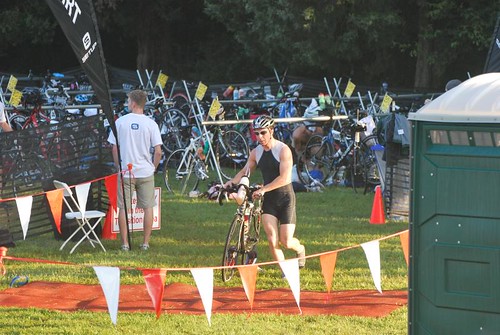
The bike out was on a short uphill piece of grass, with the mount line being an immediate 90 degree turn onto a small asphalt path, which was then another 90 degree turn about 20 feet later headed up hill. No thanks to the flying mount this time, so I just straddled the bike and got cooking on the bike.
Bike
After driving the course the day before with Rebecca, I pretty much knew where to keep an eye out for things. For example, there was a“climb” on the course came at mile 5 and again at mile 50 to go over a bridge. It wasn’t long or steep, but something to be prepared for, because it had a few grates in the pieces of concrete connecting it together, plus it was under construction, so I knew to look out for stray nails or anything that might cause a flat. There was also a 5-7 mile section of road that was on packed pebbles, which made for quite the bumpy bike ride. Nothing I could do about it, since everyone else had to ride the same section, but it was nice to know so I didn’t ruin my focus out on the course.
My goal for the bike course was to push it comfortably hard. I’ve done more cycling this year than ever, so I knew I could post a good split. My mid zone 3 HR on the bike was right around 148-150. Fresh off the swim, my HR was pretty high for the first chunk of miles out on the course. I didn’t push too hard out of the gate, per my plan, and just took the first 30 minutes to settle my body into a solid pace/HR (see green HR line below).
The first 10 miles, with the exception of the bridge (little blip toward the left in red), were a very slight downhill (think false flat), so I was pushing some good looking numbers early on. I figured that I’d be a good bit slower on the return, since I’d be tired and on the up hill part. I felt like I kept my pace steady almost the whole ride. Every 3-4 miles, or when we came to a turn, I got out of the saddle to stretch out of legs and use some different muscles. Other than that, I stuck in my aero position the whole time and flew.
About half way into the bike course, a peleton came up on me. Seeing as how I was in the first wave of the swim, there weren’t THAT many triathletes out on the course yet, so I found it interesting when a pack of 12 tri-geeked out people came up on myself and another guy who had been passing and re-passing each other. Normally when I see something like this, I just stick to my own game plan and don’t worry about them. But the problem was that they were taking up the road and definitely not following USAT rules, hence the drafting. I was hoping an official would come by, but there was no such luck at this point. It was basically 4 rows of 3 riders abreast riding on the left side of the lane. But what made it worse was that they were going the same speed as me, so it wasn’t as if I could avoid them. I was essentially boxed in (which means they were both blocking and drafting at the same time). I did my best though, by getting out of the saddle to get in front and waving through them, so I couldn’t get busted for drafting (it sure beats slowing down, which was the only other option). A few minutes later, they’d come up on me again. We went back and forth in this manner for the next 5 miles. It was quite frustrating. But then, there was redemption! An official finally pulled up and literally rode right next to the pack for at least 2-3 minutes while they continued illegally riding. One guy in particular got busted twice I believe (I confirmed it in the results), as I watched this all unfold from my safe (and legal) distance of just over 3 bike lengths back. The official was shaking his head, unable to comprehend the stupidity of the group. As a spectator to this whole event, I witnessed AT LEAST 10 penalties committed over the course of my interaction with the group (one of the benefits to being an official is officiating the race in my head while I’m out on the course, so it takes away from having to think about being tired while on the bike).
With that whole peleton ordeal over, I had about 10 miles or so left in the course. Though I was looking forward to getting off the bike, I started to feel the rumble of something not good. My stomach was sloshy and I could tell that the run would not go as I would have hoped. I did not take in any more liquids or Shot bloks for the rest of the bike, in the hopes that it would help settle down my stomach. I was still able to keep my effort strong through to the bike finish. After going over a 10 ft long really rough patch of road (quoted by the Race Director pre-race as “the worst stretch of pavement you will ever see” in his pre-race speech) that resembled the moon craters, I came to stop with my flying dismount and entered T2.
Time: 2:41:02 (15:04 PR over Eagleman)
Avg Speed: 21.6 mph
Avg HR: 151
T2
I was able to make a pretty quick transition, though it could have been faster, based on some T2 times I have posted from previous races of a similar size transition area. I only had to put on my shoes, rack my bike, take off my helmet, and grab my run hat (which already had my race belt and nutrition sitting in it), so it was pretty simple. I think I got a stomach cramp (the first sign of trouble) as I began running out of transition.
Time: 1:12
Run
I started off at what felt like a controlled pace on the same up hill that we had to climb out of at the start of the bike. After about ¼ mile, it flattened out, where we continued on for a short out and back section, which we only had to do once, before entering the first of 2 laps. I hit mile 1 in 8:20 to my shocked amazement. I felt alright and kept checking my HR to make sure I wasn’t going out too hard too soon. Mile 2 came through in 8:40, as I forced myself to pull back some on the pace, because I just wanted to play it safe so early into the run. 
I started with an easy jog and progressively felt better. I passed by Rebecca and a friend who came down from
I finally hit the turnaround for lap 2/mile 7 and actually started to feel alright. A very short while later, I was in much better spirits and I passed by them again and told them I’d see them soon at the finish. I even smiled for the camera.
The next several miles were kind of a blur. I felt ok running, but for some reason I continued with more walk breaks. These only happened at the aid stations, but a couple of them got longer than I should have let them and cost me time. I was very diligent at first with only walking for 15-30 seconds, but I found myself in a few cases on extended 1 minute walks. I’d tell myself “I feel fine and there is no reason to be walking. The quickest way to finish is to run.” And I’d start running again to the next aid station. My last couple of miles were back on pace with my shorter walk breaks, but to be honest, I am regretful that I continued to take walk breaks in those last few miles, because there was no reason. I should have just pushed through.


I ran the last 1.5 miles and began picking up the pace once I could hear the announcer. I finally entered the path to the finish line, when a guy came up on me from behind and encouraged me to pick up the pace even faster and we’d push it to the finish.
I didn’t really want to, but I was only about 50 feet from the finish, so we pushed it hard, coming in at 5:34:51, a PR by 32:54 minutes!
Happy to be done :)
Time: 2:01:29 (PR by 17:13 over Eagleman)
Pace: 9:15/mile
Avg HR: 151
Once I stopped moving, I felt another wave of stomach issues coming ASAP. The volunteers were handing the medals, taking our chips off our ankles, and giving us water. I needed it done much faster than they were moving, so I grabbed mine and ran off to the side about 3 feet from the finish line. Everything else that I took in from Mile 5 – 13.1 was released onto the grass. And I think some internal stuff too, because I saw some colors coming out of me that I know didn’t come from any food I ate. I had an extended session with nature for a solid 5 minutes, while Rebecca, my parents, and our friend (and all the other spectators) looked on. It was WONDERFUL. (sorry, no pictures!)
After I was finally done, I grabbed a regular coke in the hopes of taking in some calories and having the carbonation help to settle my stomach. And it did. I took in a little bit of the mac and cheese they had as part of the post race food and began feeling much better. After that, I didn’t feel sick again.
On our way headed out of town, we stopped to get gas, and I noticed this sign.
 Are there really hot dogs that AREN't all meat?
Are there really hot dogs that AREN't all meat?
Summary
This race was the culmination of nearly 6 months of training for a single race. I rode my bike more than I ever have, completing my first century several weeks earlier in the process. My run training wasn’t quite where it should have been, and my swimming still sucks. Bottom line is that I need to have help with my swimming. I put in a lot of time in the pool, and despite being able to cover the distance with relative ease, I am still way slower than I am, when compared to how I fare in cycling and running. Something has to happen with my swimming for me to think about improving my times. But that’s the good news – there is still plenty of room for improvement, despite the huge PR.
So with that, I’d just like to thank Rebecca for her support of my training throughout this summer. I really wanted to hit this race hard and race close to my potential. I feel like I accomplished that goal, but I couldn't have done it without her support. I know it was difficult not having me around as much on the weekends, while I was off on my long bike rides. It means a lot to me that she supports this crazy lifestyle and all its demands. I couldn't have done it without her.
Now that my season is unofficially over, we have lots more time to explore all the fun things we (I) had to put off over the last few months.
